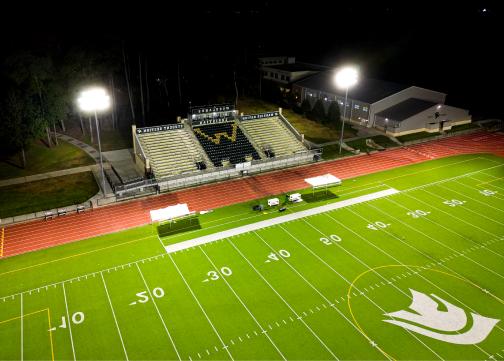Recommended illuminance level:
Horizontal illuminance: 100 fc. CV = 0.13 or less. (Emax/Emin = 1.7:1 or less)
Illuminance readings should be taken at a 1m (3’) elevation on a 9m x 9m (30’ x 30’) grid.
Class II of competitive play is any competition that is played before a group of up to 5,000 spectators. Lighting criteria for major stadiums and arenas require special design considerations such as vertical and horizontal illuminance values not covered by this practice, which may be defined by individual sports governing bodies and/or broadcasting organizations.
Recommended illuminance level:
Horizontal illuminance: 50 fc. CV = 0.17 or less. (Emax/Emin = 2.0:1 or less)
Illuminance readings should be taken at a 1m (3’) elevation on a 9m x 9m (30’ x 30’) grid.
Class III of competitive play is any competition that is played before a group of up to 2,000 spectators. Lighting criteria for major stadiums and arenas require special design considerations such as vertical and horizontal illuminance values not covered by this practice, which may be defined by individual sports governing bodies and/or broadcasting organizations.
Recommended illuminance level:
Horizontal illuminance: 30 fc. CV = 0.21 or less. (Emax/Emin = 2.5:1 or less)
Illuminance readings should be taken at a 1m (3’) elevation on a 9m x 9m (30’ x 30’) grid.
Class IV of competitive or recreational play only, with limited or no provision for spectators. Class IV lighting levels are suitable for play at fields that do not draw a large number of spectators. Many fields that host competitive play for adult recreational leagues will have very few spectators. Games for youth leagues will typically only be attended by family members of the participants.
Recommended illuminance level:
Horizontal illuminance: 20 fc. CV = 0.25 or less. (Emax/Emin = 3:1 or less)
Illuminance readings should be taken at a 1m (3’) elevation on a 9m x 9m (30’ x 30’) grid.
National LED can be your go-to sports lighting company for field layouts and turnkey installations.
American and Canadian Football Differences

Quick links to get you started:
Pole Quanity, Location, and Height
The number of lighting poles in a stadium can range from 4 to 8, with flexibility in their placement to avoid obstructing spectator views.
One common approach is to position the poles behind the bleachers. Alternatively, placing poles in the corners of major stadiums is also acceptable, eliminating the need for a long setback behind the grandstands. However, in a four-pole layout, taller poles and longer aiming throws for the floodlights may be required.
The specific height, offset, and setback of these poles are determined based on the stadium and site configurations to ensure optimal illumination while preserving the spectators’ experience.


National LED can be your go-to sports lighting company for field layouts and turnkey installations.